Mind the heat gap
Global heating has made it impossible to ignore: investigating London's future heat disparities.

In cities across the world, there exists a strange anomaly: different areas of a city can experience different ambient temperatures, up to a staggering 10 degrees celsius difference.
A pattern emerges of 'heat islands', the hottest places on the hottest days within cities, and these are usually dense and residential, home to ethnic and minority communities, and income-deprived. Why are these 'heat islands' absorbing, radiating, and trapping more heat compared to their richer counterparts?
This heat gap is no coincidence.
Vivek Shandas, a Professor of climate adaptation at Portland State University, has been studying intra-urban temperature variability for years to figure out how one neighbourhood can be physically hotter than the next.
In America, where the phenomenon is most pronounced, Vivek and his team of researchers found that the heat gap could be explained as a consequence of a historical policy called 'redlining'. Dating from the 1930s before it was abolished in the 1960s, the policy involved putting neighbourhoods that had lower-income communities, immigrant communities, and communities of colour, inside redlines and segregating them from 'blue' and 'green' neighbourhoods.
"Those neighbourhoods that were redlined had orders of magnitude less tree canopy, less green space, parks and natural spaces than their non-red-line counterparts, and the explanation to me was a systematic process where we were making decisions for decades about where we were going to invest our resources, and where we were going to disinvest," said Vivek.
Neigbourhoods that were redlined were on average about five degrees hotter than their non-redlined counterparts across the board in 108 American cities.
What Vivek discovered was that where you live within a city - something decided by your income and status - and your surrounding environment can change your exposure and vulnerability to heat.
The decisions in investment; quality of housing stock; and the placement of urban ecosystems, in certain areas have present-day implications for cities and consequently, these social and political processes mediate and inscribe onto the landscape differences in where the heat is greater and where the heat is less.
American neighborhoods that were disinvested for decades because of redlining began to decline in land value. As a result, they became the places where hungry developers built highways, freeways, big box stores, and parking lots, because the land was cheap and these things require cheap land. "Those disinvested neighbourhoods and the adjacent neighbourhoods that live alongside these heavy, industrialized areas bear the brunt of all the heat that's been amplified in these locations as a result of those land use decisions," Vivek said. The communities in these areas pay more for air conditioning, experience multi-generational heat health impacts, and are experiencing greater social discord (studies have shown a link between increased violence and heat): all because their neighbourhood is literally hotter.
"Our social and political decison-making processes can marginalise neighbourhoods at one point in time and then decades later those same neighbourhoods end up facing the first and worst impacts from a changing climate."
Vivek's research has moved beyond the U.S., to studying apartheid communities in South Africa, to Indonesia, to Brazil, and everywhere he goes, disturbingly, a heat gap is apparent: "We're starting to see some inkling that the same patterns are existing across any city in the world."
London is already a city of contradictions. It is the poorest city - with the highest amounts of poverty and income deprivation in the country - but also the richest. That makes it the most unequal place in the UK.
Roger Burrows, a Professor in Global Inequalities at Bristol University, calls London a "plutocratic city" that "functions in the interests of a global wealthy elite rather than for the majority of people within the city." He believes that for more than two decades, political decision-making in Westminster and City Hall has led to the "advantaging" of a very wealthy people, often transnational wealthy, rather than the interests of the wider citizens within London.
Alex Bax, chairman of MyFairLondon - a group of Londoners campaigning for a fairer capital - agrees, and is worried by the "stretching out" of the city's social gradient. "Compared to other cities - we're not as socially segregated as Sao Paulo or some American cities - we remain quite a socially mixed city, but the structure of the city is becoming more unstable. There are more poor people than there should be, and more rich people than there should be, and that's because the people in the middle can't afford to live here. The UK's social structure is unequal anyway, but London is an exaggeration of that and it drives certain people out."
The dominance of money is most evident in West London, where whole squares and streets seem to be sequestered as enclaves for the wealthy and well-heeled. The city's planning is representative of the polarisation of rich and poor across boroughs ... and of unspoken segregation. "It manifests itself primarily through the erasure of public housing and the displacement of large populations of socially disadvantaged people from areas where the value of land is such that those areas can be replaced and new builds constructed which sell for many thousands, often many millions of pounds," Burrows said.
With global heating making London's summers warmer - it might experience a Barcelona-like climate by mid-century - and heatwaves more intense, it is likely that the city's own hyperlocal heat islands will become more explicit.
Mike Childs, head of Science, Policy, and Research at Friends of the Earth, an environmental organization that "marries the need to deliver on environmental goals with making sure we're looking after people" says that the heat disparity seen in American cities and others can already be identified on home soil. "We already have some of those divides in London. The leafy parts of London will be where the, broadly speaking, where the wealthier people live, and it'll be places like Newham and Hackney that aren't."
Friends of the Earth commissioned Manchester University to conduct a study to identify which communities were most socially vulnerable to the health impacts of heatwaves. To find out which neighbourhoods were most vulnerable, they looked at 40 different indicators like age and ethnicity. Mike establishes that the local environment was an important factor but also points out some surprising factors that add to heat disparity: "If you live in an area that has high crime, you're less likely to leave your window open at night to cool down."
They found seven London boroughs were in the top 10 areas in England which will be worst hit by heatwaves.

Westminster Bridge, London - A picture of the iconic Houses of Parliament in Westminster. London has been ranked the "wealth capital" of the world, but has the highest poverty rate in the UK. Photo credit: Samuel Hewetson
Westminster Bridge, London - A picture of the iconic Houses of Parliament in Westminster. London has been ranked the "wealth capital" of the world, but has the highest poverty rate in the UK. Photo credit: Samuel Hewetson
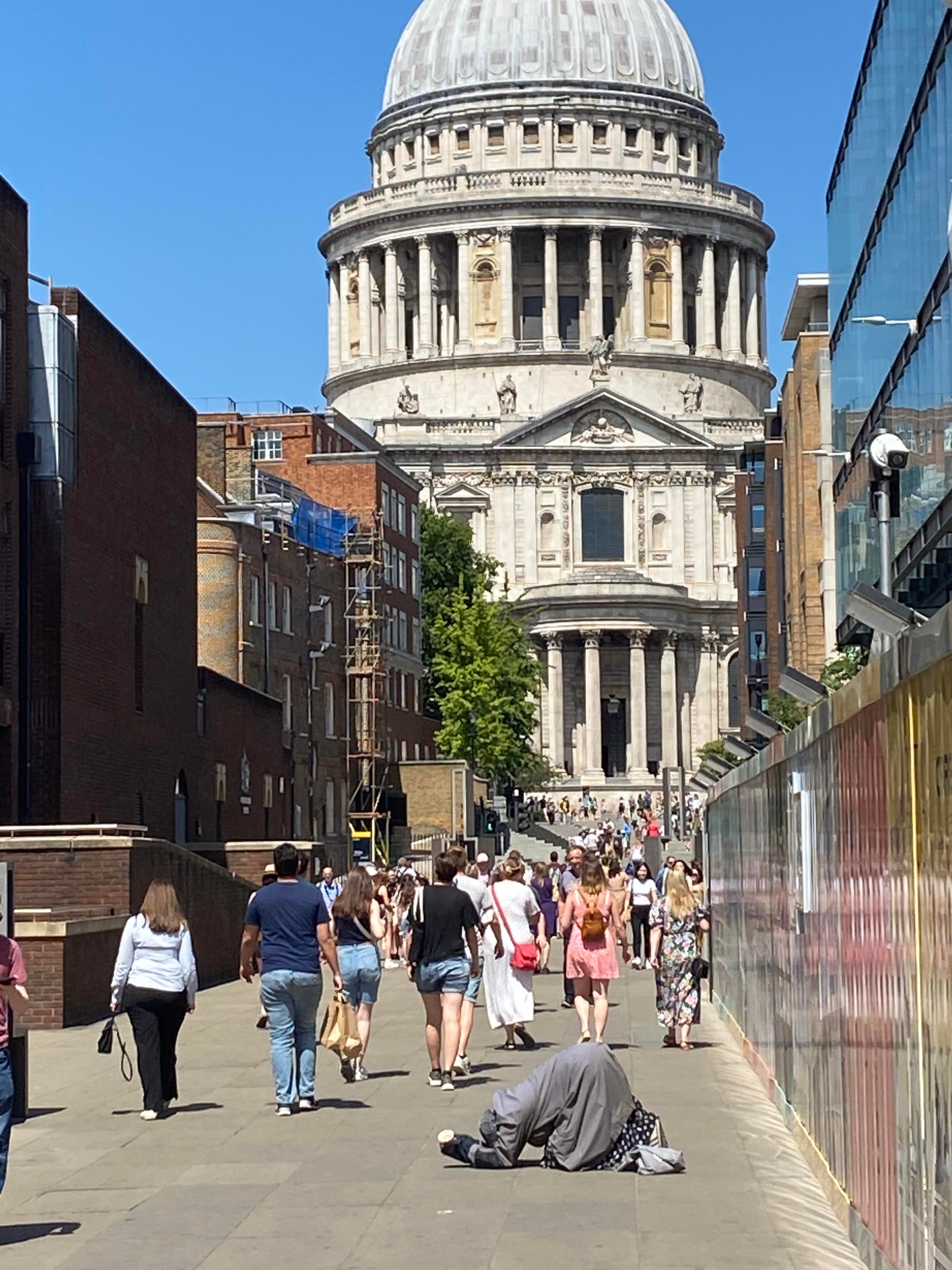
Millennium Bridge, London - A veiled woman begs for money, during the July 2022 heatwave, against the backdrop of St Paul's Cathedral. According to the Trust for London, 28% of people live in poverty in London compared to 22% in the UK. Photo credit: Samuel Hewetson
Millennium Bridge, London - A veiled woman begs for money, during the July 2022 heatwave, against the backdrop of St Paul's Cathedral. According to the Trust for London, 28% of people live in poverty in London compared to 22% in the UK. Photo credit: Samuel Hewetson
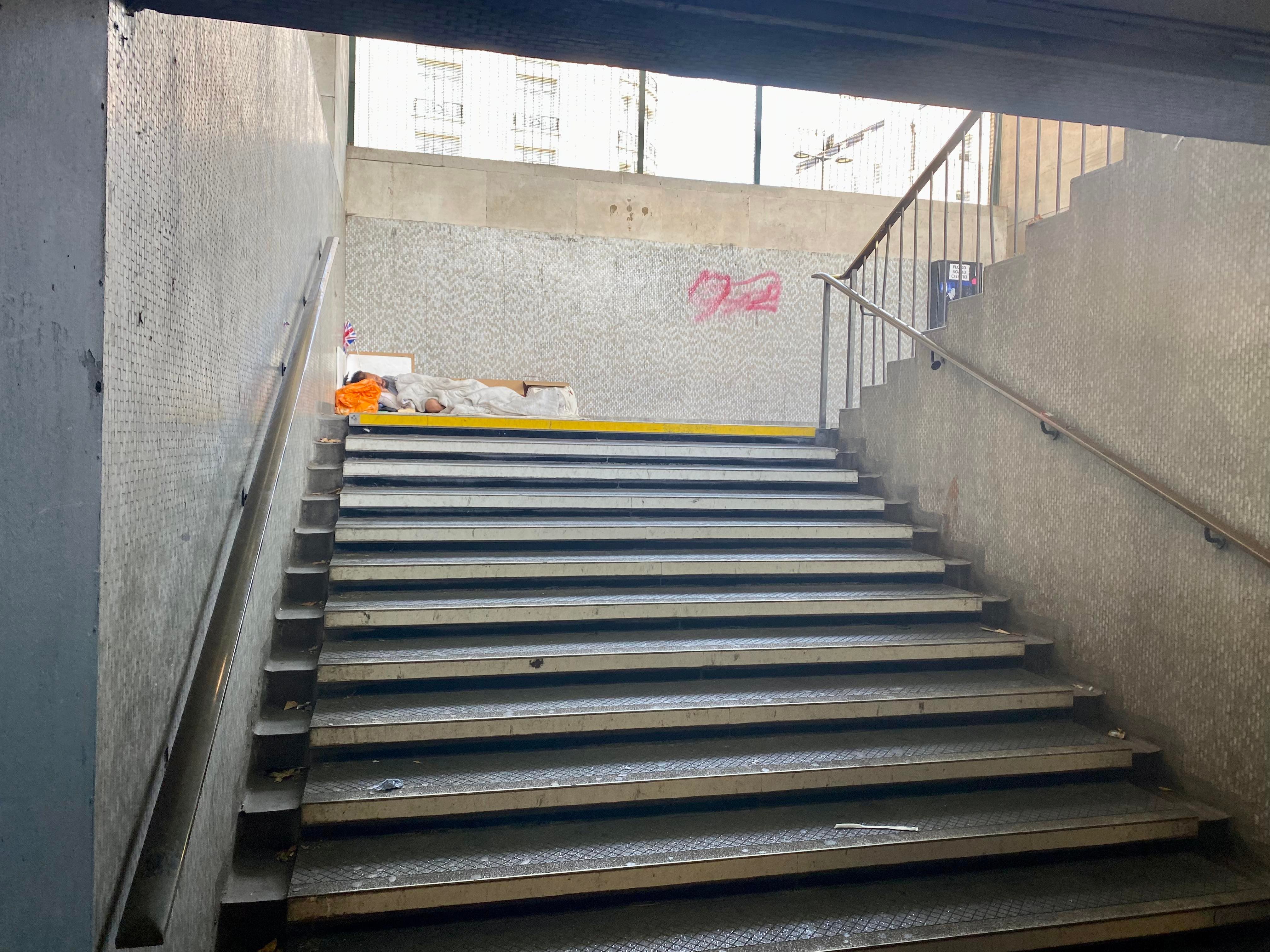
Marble Arch, London - A homeless person seeks shade from the sun in a staircase leading down to Marble Arch tube station. According to homeless charity Streets of London, 27% of England's rough sleepers live in the capital. Photo credit: Samuel Hewetson
Marble Arch, London - A homeless person seeks shade from the sun in a staircase leading down to Marble Arch tube station. According to homeless charity Streets of London, 27% of England's rough sleepers live in the capital. Photo credit: Samuel Hewetson
'To them that hath shall be given'
Where you live in London can not only influence your vulnerability to heat, but the opposite too: your capacity to cool down. The unequal policy-making that creates 'heat islands' also dictates the placement and accessibility of 'cool spaces' like centres and pools, and whether or not urban ecosystems - parks, green space, and tree canopy - is within walking distance.
Trees and woodlands provide benefits anywhere in terms of landscape and biodiversity, but in urban areas, they are a vital weapon in the war against heat. Their urban cooling impact is second to none, providing shelter and shade from extreme heat for both people and buildings, and their natural transpiration - a plant's nutritional and respiratory cycle - means they emit cooler, moister air that can help negate the urban heat effect. As objects in the public realm, they provide both active cooling and passive cooling, and it's why they are so essential to the adaptation agenda.
The Woodland Trust champions tree-friendly policies in London and Bridget Fox, the regional external affairs officer, affirms that urban trees are absolutely essential for climate resilience: "The single best investment you can make at the moment in environmental terms is to plant a tree."
But wealth and greenery is closely intertwined within London. "There's a reason that leafy streets have been seen as a synonym for affluence," says Bridget.
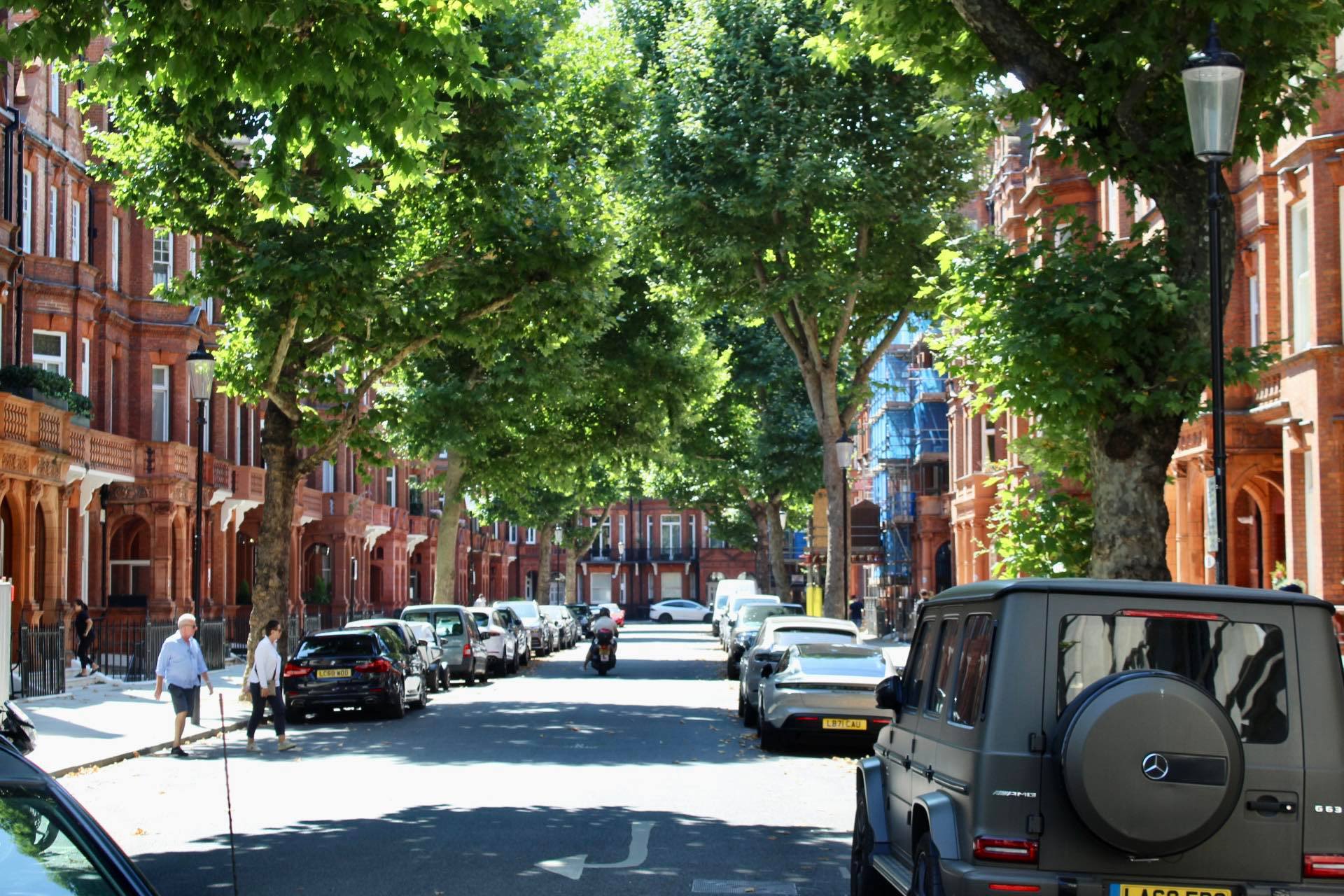
A tree-lined street near Sloane Square, on the boundaries between Belgravia and Chelsea. Photo credit: Samuel Hewetson
A tree-lined street near Sloane Square, on the boundaries between Belgravia and Chelsea. Photo credit: Samuel Hewetson
Like the disparity in wealth, walking between boroughs reveals that some have more green space and tree canopy covers than others, and therefore there is a great disparity in terms of who exactly benefits from their cooling abilities. And there is, as established, considerable overlap between marginalized neighbourhoods that are vulnerable to heat and the areas with less shade.
The Woodland Trust advises London boroughs with tree canopy cover targets, and actively encourages them to find new places to create green infrastructure, especially in places like East London, where large-scale housing development often regenerating existing built-on industrial sites, could take the "opportunity" to create green space amenity and "bring the multiple benefits to people" - including cooling, says Fox.
"Who doesn't deserve a tree? Who doesn't deserve access to woodland? The answer is nobody."
"There tends to be an element of 'to them that have shall be given': areas which are already leafy, tend to have more parks, and larger gardens, and so more potential to plant and sustain trees and woodlands," says Bridget.
There is the risk of an insidious process called 'green gentrification', where green infrastructure and green planning (although inherently an attempt to improve the living environment) create urban inequities by also improving an area's aesthetic quality, consequently increasing the value of land and housing within that area and pricing out those with lower incomes. Green gentrification pushes poorer people back into surroundings filled with concrete and benefits only the wealthier occupants of an area.
"Clearly there is something very wrong that if you improve an area's environment people are priced out of it. This is a social problem because everyone should have the benefit of a clean and cool environment, it shouldn't become a luxury item. And obviously is every area is wooded, every area is tree-lined, every area has those benefits, it won’t become a differentiating factor between gentrified and more economically inclusive areas."
The working from home revolution and heat
The COVID-19 pandemic fundamentally changed how we live and how we work.
Remote-working, a sensible public health measure introduced temporarily to reduce the transmission of coronavirus, has become a permanent fixture of our economy and society. In London itself, research by King's College London reveals that 61% of Londoners are now 'hybrid-working' (splitting their working hours between home and the workplace) and three in four don't think they will ever return to the 'old way' of five days or more in the office.
Whilst the working from home revolution has undoubtedly increased the quality of life for many, it has entrenched inequality further by tearing open a fresh chasm between rich and poor: middle-class and wealthy workers are more likely to hot-desk from home, but the working class occupy roles - like retail, construction, and service jobs - that demand them to be physically available.
"Certain parts of the population were able to work from home and therefore be less exposed to disease transmission, so similarly with heat if you have a manual job you might inevitably be more exposed," says Dr Anna Mavrogianni.
This new wound in the fabric of society has, unexpectedly, changed the risk of exposure to heat for the less affluent - in more ways than one.
One of the motions of modern-day city life is the 'dreaded' commute, and 80% of Londoners who remote-work say avoiding it is the biggest benefit.
But thousands of people - who can't afford a car, who are old or affirm, who live with a disability - need to commute, and a working, comfortable, high-standard public transport is an essential right.
Yet, in London, heatwaves throw a spanner into the works.
Extreme heat is problematic for the physical dimensions of any city - the roads, railways, water supplies, power grids and health service - but for a city with an extraordinary history like the Big Smoke, built for a totally different climate, it is even more vulnerable. Placing a polar bear in a rainforest, and expecting it to survive, would end in disaster - the same applies to London in a heatwave.
Nothing is more emblematic of this inability to adapt than the conditions of the iconic Underground during the summer months. As any commuter in a Central Line tube carriage knows all too well, face crammed up against the armpit of another passenger, the heat is brutal. The air is stiflingly hot, like wading through hot soup, and poorly ventilated. The temperatures in the tunnels and on platforms can get so hotter than the air above that Transport for London (TfL) regularly advises passengers to carry a bottle of water on their person at all times if traveling on the deep-underground lines.
During heatwaves, conditions become even more hellish - people traveling on the Tube can be subject to temperatures higher than the maximum limit for safely transporting cattle. The London populace withstands it with a grim face.
But as the future of regular 40-degree celsius heat waves rapidly approaches, could the Tube become unusable?
TfL is mulling over the possibility and considers heat as one of the biggest environmental challenges it faces; for both its infrastructure and the health and safety of passengers.
"In terms of heat itself, there are massive potential risks for all infrastructure: hospitals, care homes, schools, people's homes. But for transport, there are things like rail buckling; this is where rails expand in the heat and can then deform. When it comes to roads, you're looking at melting asphalt, and when it comes to rolling stock, you're looking at overheating of buses and trains, and it just being a not very pleasant environment for staff or customers, and particularly those with underlying health conditions. For the very old and the very young, high temperatures can exacerbate existing health issues," says Katherine Drayson, Strategy and Planning Manager for the Environment at TfL, who works on green infrastructure and climate change adaptation projects.
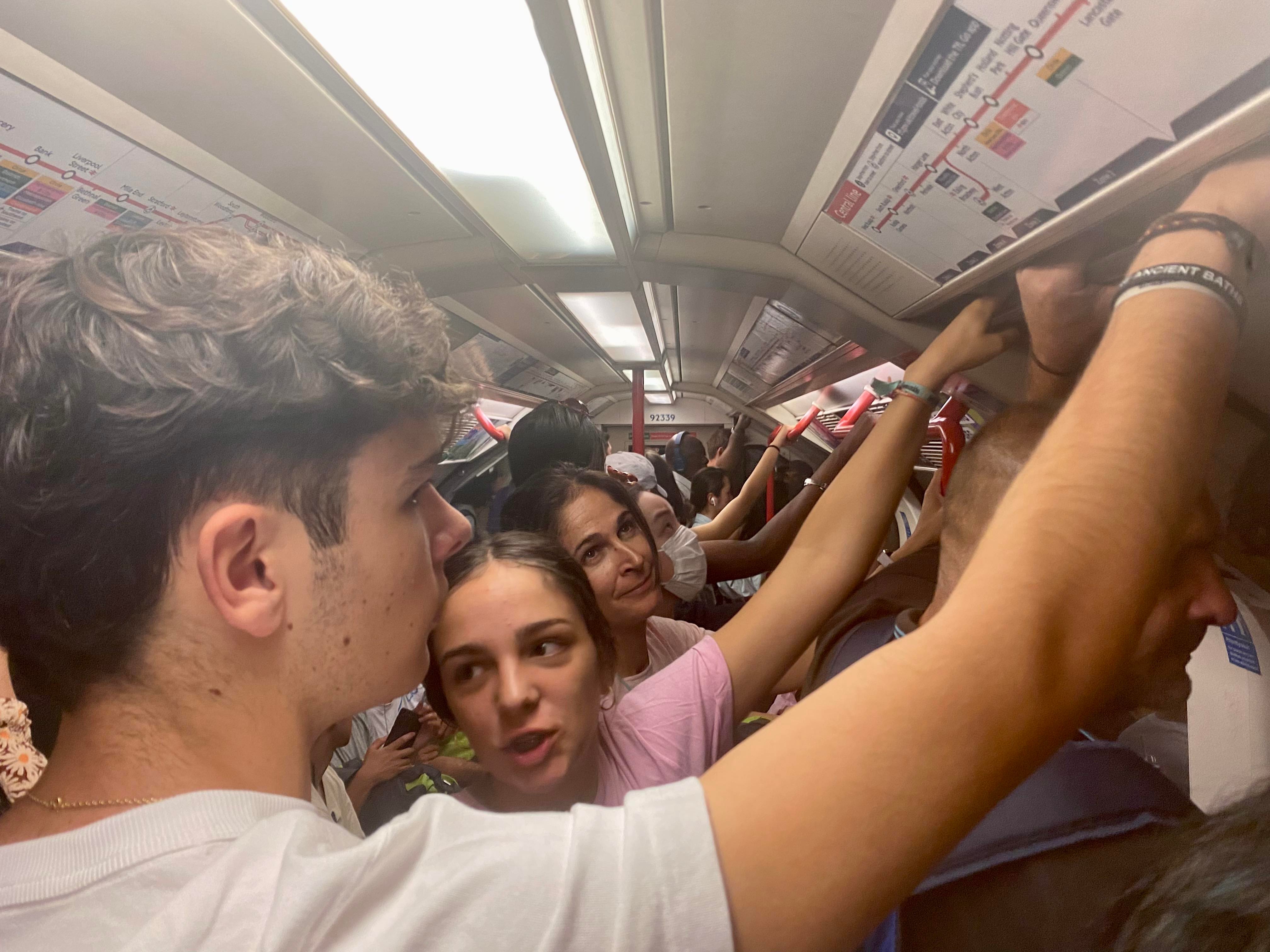
Passengers are crammed together on the Central Line - one of the busiest deep-level Underground lines and routinely one of the hottest - during the July 2022 heatwave. Photo credit: Samuel Hewetson
Passengers are crammed together on the Central Line - one of the busiest deep-level Underground lines and routinely one of the hottest - during the July 2022 heatwave. Photo credit: Samuel Hewetson
The London Underground is the oldest metro system in the world and that makes modernization painfully slow, painfully expensive, and painfully improbable. Whilst Drayson makes clear that some overground and sub-surface lines have been air-conditioned, totaling about 40% of the network, cooling the rest of it remains a herculean task.
Ironically, the Underground was once advertised as a place to escape the heat above ground and stay cool. Without a magic ball to peer into a future of global heating and deadly heatwaves, the Victorian planners and engineers that built the oldest tunnels made them wide enough for the trains themselves and not much else; leaving their present-day counterparts scratching their heads on how to adapt them. The cramped, narrow tunnels have no space to install traditional air conditioning units, and even if there were, most lines lack the necessary amount of ventilation shafts in which to jettison the excess heat created by active cooling systems. Without them, it would create a vicious feedback loop of heat, making the Tube even hotter.
"There just isn't the capacity for that [air conditioning], and also one of the things we're thinking about is the tradeoff between adapting to climate change, but also reducing our carbon emissions, so air conditioning isn't necessarily where we'd want to go anyway because you know not only does it release potentially quite a bit of carbon depending on where the energy comes from, but also air conditioning has to put the hot air somewhere, and often that's on the platform. There are big tradeoffs that we have to consider," says Drayson.
The London Underground takes up to five million passenger journeys a day, and without the necessary changes being made, that is five million passenger journeys at risk. Bob Ward, chair of the London Climate Partnership, is worried about a disaster on the deeper line during a 2003-like heatwave. "We know that heat causes increased problems for the tube. The heat itself interferes with the equipment, and so increases the risk of malfunction. And so if you get trapped on a tube, on a train underground..." He trails off, leaving what could happen to the imagination. The working-at-home revolution could mean a disparity in terms of who is impacted by such an event.
Drayson recognizes the weight of expectation on TfL's shoulders, and the organization does see adapting to climatic risks like extreme heat as a priority.
"Equalities play into the adaptation agenda," Katherine says. "We're very conscious of the need to provide a safe and reliable public transport network for those who otherwise couldn't afford to get around."
Indoor environments are not a level playing field during a heatwave either.
Dr. Anna Mavrogianni is a Professor of Sustainable Building and Urban Design at UCL's Bartlett Faculty of the Built Environment, and her research career focuses on the adaptation of our urban built environments to a warming climate and the impact of climate on energy use.
Mavrogianni emphasises that living within London with a higher income could mean being able to afford the means of adaptation to future heatwaves, to afford relief: "I think as we look into the future and see increases in temperature and increased frequency and severity of heatwaves, there is also a concern that higher income groups might be better at adapting and coping with hotter climates because they can a) either afford air conditioning or b) might have bigger homes. They might not be trapped in a tiny flat on the top floor and they have the ability to go on holiday during the warmest part of the year."
Different housing creates different exposures to outdoor temperatures and therefore lower or higher indoor temperatures for its occupants. The quality of housing you live in, and whether or not it can overheat, Mavrogianni explains, is one of the major contributing heat-health risks during a heatwave.
“In terms of exposure to the outdoor temperature, there are lots of epidemiological studies and there are well-established thresholds of outdoor temperature when excess heat-related mortality and morbidity increase in relation… for London, mortality increases when outdoor temperatures rise above 24.7 degrees.”
Inside is a different story.
"In terms of the similar thresholds for indoor environments, this is less well understood. But the type of building we occupy can significantly modify our exposure to outdoor temperatures."
Many British homes already overheat during relatively cool summers because they're poorly designed, have little natural ventilation, and heat-health advice, like the importance of shutters and blinds to keep out sunlight during the day, is rarely heeded. London is not an exception to the rule - Alex Bax cautions that the city's housing stock "is not well adapted to the temperatures we've got today, even less well adapted to the temperatures we're going to get in the future, and that will play out unfairly."
Your quality of housing exists in a symbiotic relationship with your income. At one extreme, being poor means no housing at all. Shelter reports that more than 60% of England's homeless live in London - that's 1 in every 52 people - and being homeless means being regularly exposed to weather events. Shockingly, the Dying Homeless project by London's Museum of Homelessness concluded that more people die homeless in summer than in winter. On the other extreme, rich people have premier-quality housing, and often multiple abodes - some in the city, some in the countryside, and even abroad - all of which might be physically cooler by design or by luxury items like pools.
Mavrogianni explains that certain types of buildings are more prone to overheating than others. Generally top-floor flats, in high-rise purpose-built blocks, are some of the worst culprits. High mortality in Paris 2003 was associated with people living in the attic apartments at the top of their buildings.
These flats get more sun, and less shade, and deal with hotter air as it rises up through the lower levels.
Orientation in regards to the sun, building materials, and cross-ventilation is also key. In a building that faces only one direction, there is no circulation of airflow.
"It is poor people who are living in relatively poor quality accommodation where the homes are badly designed and therefore more prone to overheating," says Bob Ward. He says we need a "national rollout of measures to tackle heat," particularly in London, and that we can start by "going first to those properties where there's the biggest threat, and that's often social housing where people on lower incomes are living because that's where you can have the most impact."
In cities across the world, air conditioning is a necessity in dwellings that overheat. In London's homeowners' own search for coolness, the demand for them will heighten. But it is likely that the poorer denizens of the city won't be able to squeeze this into their budgets, especially during a cost of living crisis.
"Poor people in every country are those who are most at risk from climate change because they don't have the additional income to be able to spend on their own adaptation," argues Bob. "At a time when people are struggling to pay bills, the last thing people can afford is to buy air conditioning and run it throughout summer."
"You might be familiar with the term winter fuel poverty, which is a huge issue in the UK, especially with increasing gas prices." Dr Mavrogiannia says. "But as we expect to see an increase in installation of air-conditioning systems, we also expect to see summer fuel poverty. This is a big concern for the future."
It is a type of energy poverty already familiar to cities like Madrid, now encroaching upon more northerly locations due to global heating.
A disturbing parallel between the UK's winters and summers emerges. In winter, many people cannot afford to keep the heating on and stay warm. In future summers, many people won't be able to afford to cool down.
Being squeezed between two hostile seasons is a disturbing future possible for the UK's income-deprived. In winter, many people cannot afford to keep the heating on and stay warm. In future summers, many people won't be able to afford to cool down.
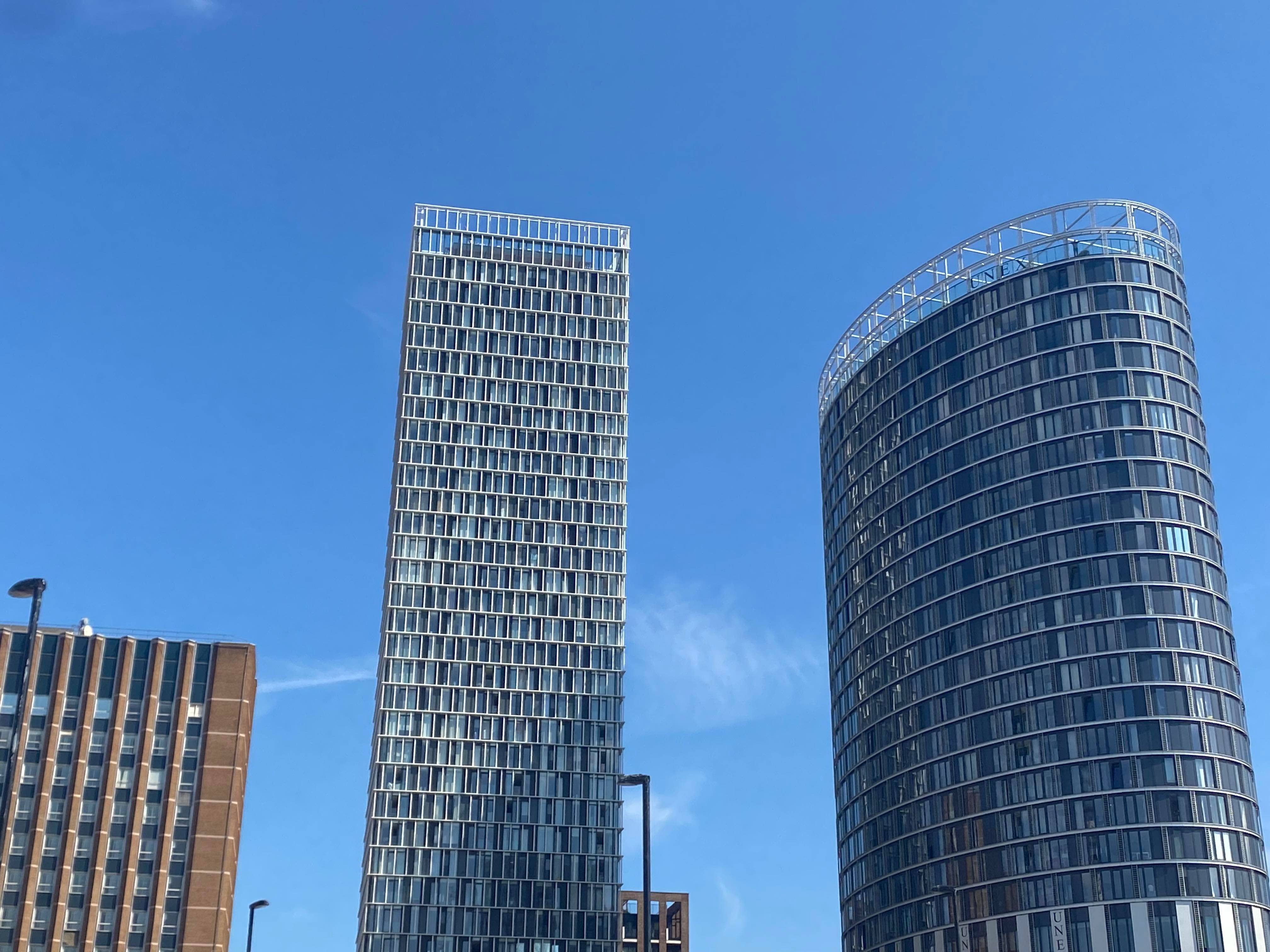
A high-rise in London. These are some of the most vulnerable buildings to heat. Photo credit: Samuel Hewetson
A high-rise in London. These are some of the most vulnerable buildings to heat. Photo credit: Samuel Hewetson
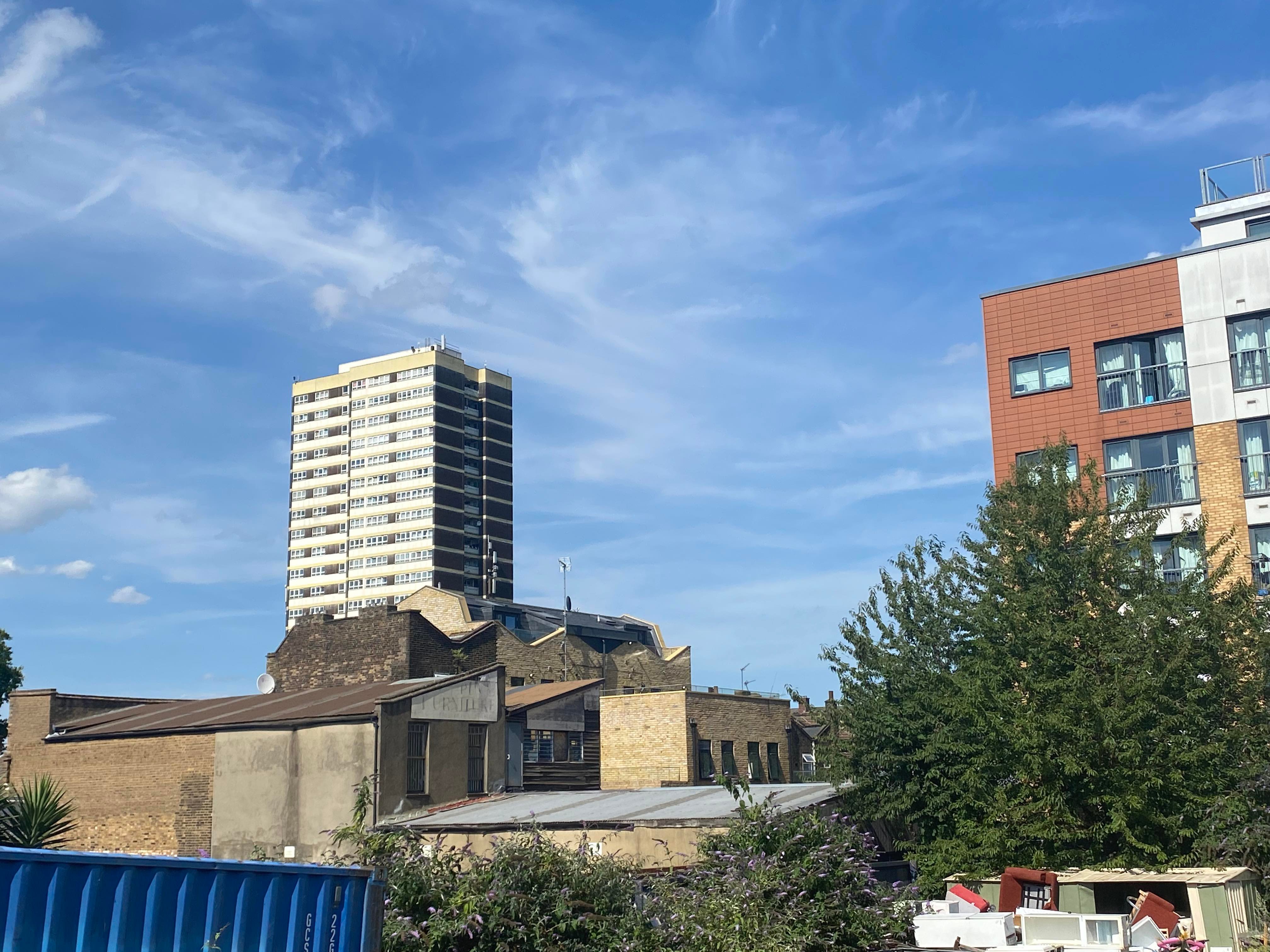
A tower block in Stratford, in the borough of Newham - one of the most socially disadvantaged areas in London. Photo credit: Samuel Hewetson
A tower block in Stratford, in the borough of Newham - one of the most socially disadvantaged areas in London. Photo credit: Samuel Hewetson
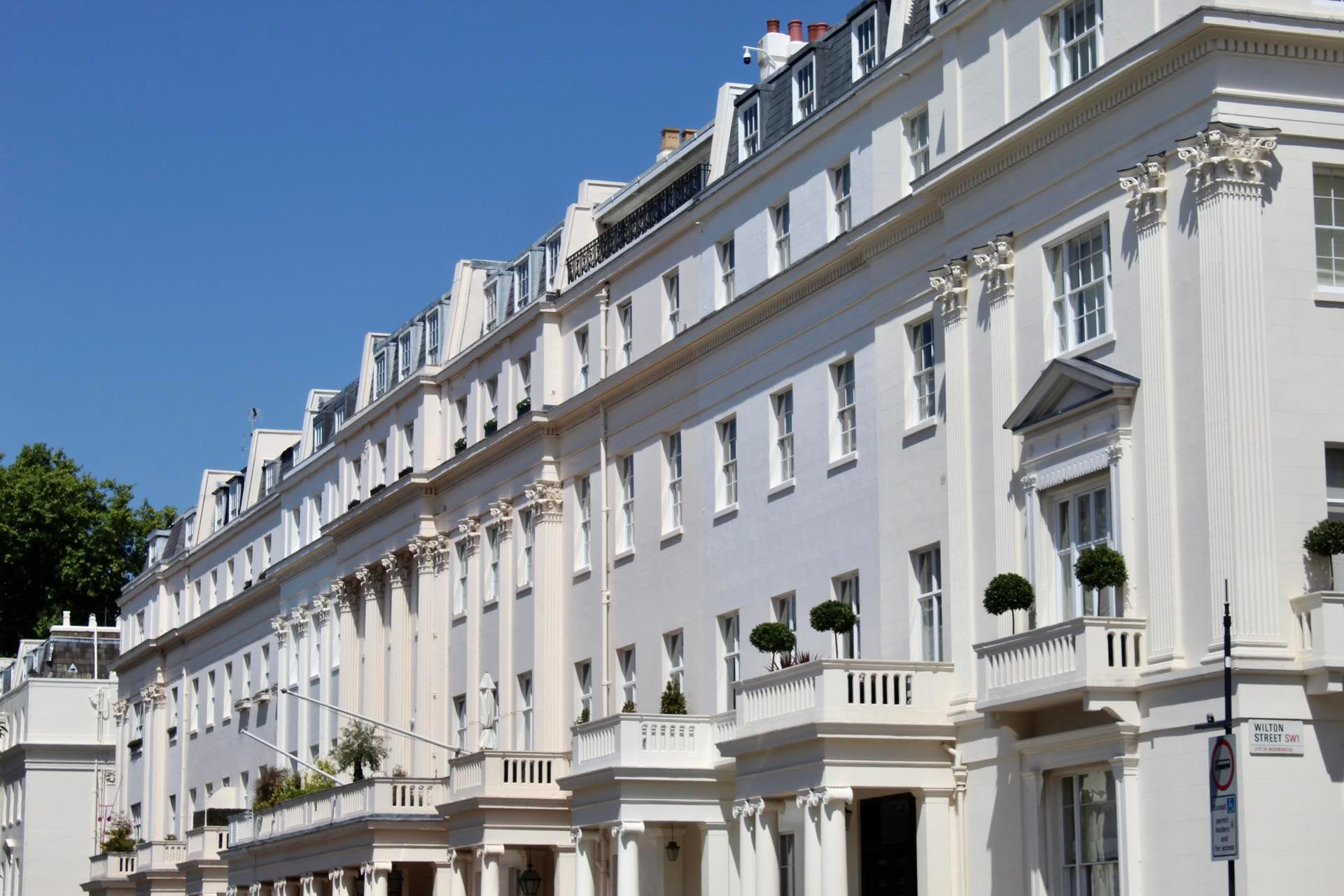
A row of stucco townhouses in affluent Belgravia, London. Wealth is unequally distributed within the city, and this is most apparent in property. According to the Trust for London, the top 10% of people with the highest wealth hold 44.3% of London's net wealth. Photo credit: Samuel Hewetson
A row of stucco townhouses in affluent Belgravia, London. Wealth is unequally distributed within the city, and this is most apparent in property. According to the Trust for London, the top 10% of people with the highest wealth hold 44.3% of London's net wealth. Photo credit: Samuel Hewetson
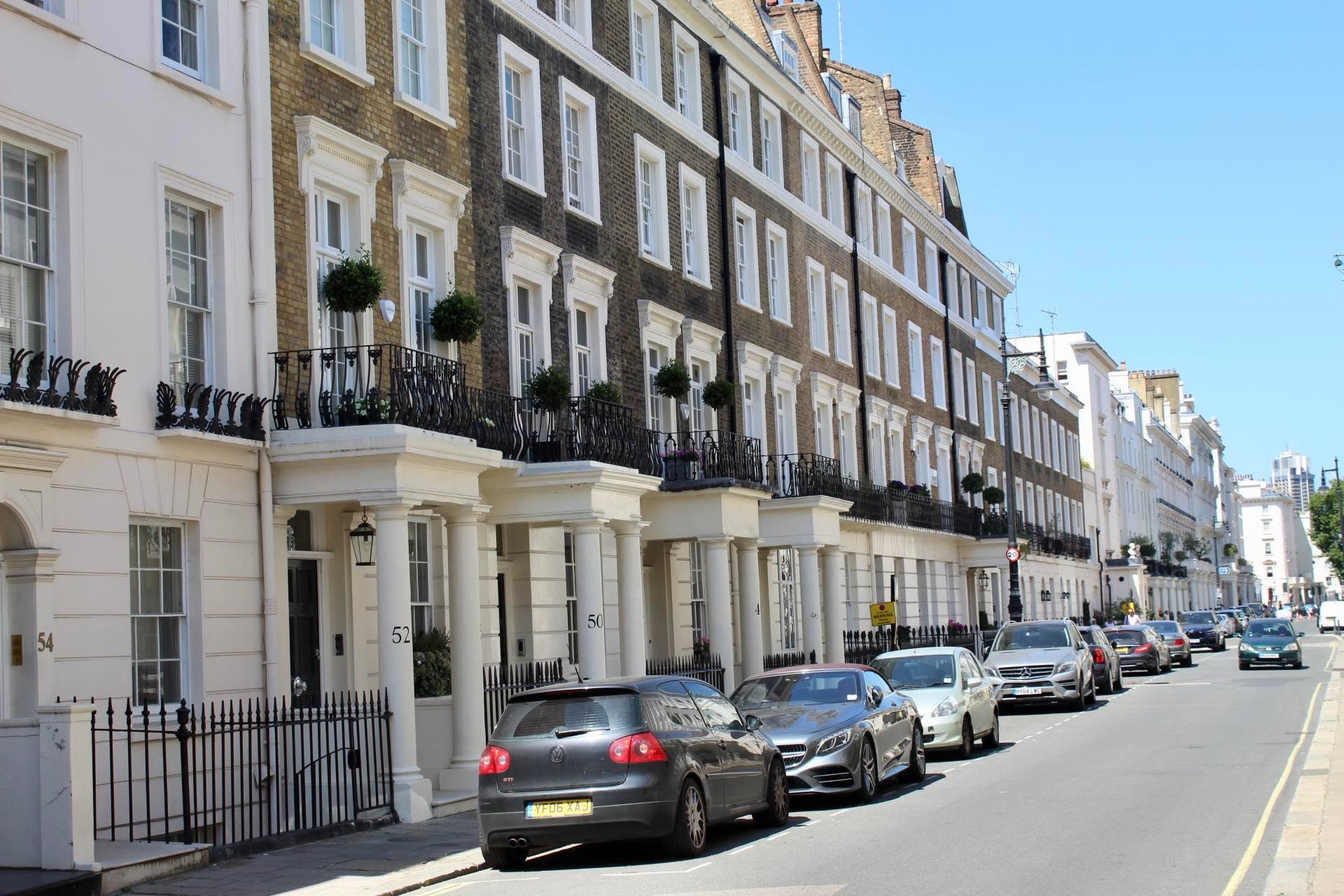
Sixty-eight of the super-rich's "mega-basements" are located underneath streets like this in Kensington & Chelsea, one of the wealthiest boroughs in London. Photo credit: Samuel Hewetson
Sixty-eight of the super-rich's "mega-basements" are located underneath streets like this in Kensington & Chelsea, one of the wealthiest boroughs in London. Photo credit: Samuel Hewetson
The haves and have nots
Wealth is the most practical means by which someone can insulate themselves from the effects of climate change, and London's rich are best positioned to adapt their environments in response to weather events like severe and recurrent heatwaves. In fact, they are already doing so.
"I expect if you were to map out the residences that had air conditioning, it would map on pretty neatly to the 'super prime areas," says Professor Roger Burrows, referring to the areas in London where real estate is in the top 5% most valuable.
The ability to make themselves less vulnerable to heat is part of a trending polarisation within the UK's capital, whereby the rich living in exclusive suburbs seem to be pulling away from the rest of society.
In the mid-to-late twentieth century, the postwar London of the 50s, 60s, and 70s was a colourful and energetic city of social mixing, where rich and poor lived quite close to each other and could brush shoulders. "But the rich in the 60s and 70s were 100 times less rich than they are today," says Alex Bax, believing that this character of the city has been lost over time. "When you're 100 times richer, you begin to buy gates on your communities and you separate yourself from the rest of us. That's what is happening. Money buys itself privilege, it buys itself space, it buys itself the nicest parts."
In the plutocratic areas of Kensington, Chelsea, and the other rich domains of London - where non-doms and large numbers of partially residential international rich decamp - the ways in which money imbues areas with a successionist impulse are evident. Carefully manicured terraced homes and whitewashed townhouses are demarcated by security guards, high walls, electric gates; there is a fortress-like, impenetrable nature. "The city is becoming more and more segregated," says Burrows. "You've got some very distinct ultra-elite enclaves that are increasingly. if not gated, then securitized in various sorts of ways."
He calls them "hollowed out" areas on account that there's "nobody there". No one in the properties, apart from a few pruning gardeners and caretakers. You can't buy milk or bread because there are no 'normal' corner shops nearby. In the new census results for London, there is a black spot in the population of Westminster and Kensington, which Roger says "wrongly" suggests a 10% drop in population. "There's not. It's just that they weren't there on census night because they all picked up to their second homes."
Beyond air-conditioning, green space, and security gates, the desire of the 'haves' to escape the 'have nots' is playing out across the urban geography of London in even extremer ways: the super-rich are 'bunkering down' and tunneling into the clay of the city.
Roger has researched and mapped out at least 7,328 basement developments underneath homes in the elite areas of London. The majority are 'modest' underground extensions - although still costing millions of pounds - that are the contemporary equivalents of a loft conversion. But, in what he calls a distinct 'basement belt' clustered around Kensington and Chelsea, Westminster, and reaching up towards Highgate and Hampstead, there are over 1,500 "mega-basements".
These mega-basements are "huge f*ck off" subterranean lairs, exclaims Burrows, that can be two to three stories down with all the trappings of wealth: cinema rooms, swimming pools, gyms, and more. Air-conditioned, too.
Although there is evidence that something similar is happening in Brooklyn in New York, Burrows calls the development "a uniquely London phenomenon". The geology of the city makes it easy to excavate the clay underneath London, but more significantly the basements are built because they play to the luxurious motivations of London's transnational wealth. "They have cultural and political sensibilities rather different from that which pertains amongst the English bourgeoisie. It's often money coming in where people have property elsewhere which have ballrooms and swimming pools, and they couldn't quite understand how they were paying so much money for relatively small houses within central London and they wanted some mechanism by which they could expand them."
The nature of inner London's planning rules meant that they couldn't build up, and they couldn't build out, but they could build down. Burrows says, enabled by politicians (the "ushers and butlers" of the elite), large swathes of London's subterranean geology have been fundamentally changed.
One of his papers calculated that the equivalent of twelve times the volume of Saint Paul's Cathedral has been extracted and dumped elsewhere for landscaping over the last ten to fifteen year period.
It is an eerie thought that if you walk around the corresponding streets, you would have no idea that metres underground a whole new 'dimension' of a city has been carved out, completely segregated and exclusive for a very small amount of people.
"They're [the basements] are symbolic in many sorts of ways. They represent how the elite never want to be on the same plane as the rest of us. If they're not in their luxified bunkers, they're in their luxified skies, or in their seasteads or their superyachts, or if they're completely crazy they're on their rockets. There's an interesting sense of verticality to inequality that is manifest within the built environment."
These underground lairs the super-rich have for themselves could become oases in a climate-ravaged London, where the rich can literally bury their heads and continue with relentless consumption. They can ignore warnings of extreme weather events - like heatwaves - which impact the rest of the city, because they feel safe knowing that they can enter their bunkers and enjoy their swimming pools and air conditioning. Roger Burrows believes so, even if it does sound a little bit like 'Don't Look Up': "Most of the super-rich, if they accept climate science, have already concluded that they're going to say f*** it and are going to do whatever they can do, architecturally, to exit. It's not just about building basements, it's about building seasteads and estates and other forms of secessionist architecture that will protect them from the worst aspects.
"There's a very frightening recognition that the super-rich are busy building things that will protect themselves and their family and the dynasties around them and the rest of us will burn and drown."
Burrows refers to a book by Will Self, The Book of Dave, that is set in the future where a surviving population finds the diary of a taxi driver in London from the early twenty-hundreds, and his scrawling are taken as a basis for a new religion. "The reason why this is so interesting is the premise that the people who find it now live in an archipelago which used to be London, and he's describing driving between different places which are 100 feet underwater and now mythical areas. They live on Richmond Hill and small clusters around Highgate Hill and Primrose Hill because these are the only bits of the city that are still surviving as little island states. It's a deeply comical book, but it's also an image of a possible future that I think is quite suggestive."
Heat-proof
London's two-tiered future - a society where the rich have insulated themselves from the effects of climate change and the poor suffer the brunt - isn't inevitable.
The city has reinvented itself in the face of danger throughout its extraordinary history, from the Great Fire of 1666 to the Blitz, and can do so again.
It needs a solution to heat-proof itself, and there are solutions: